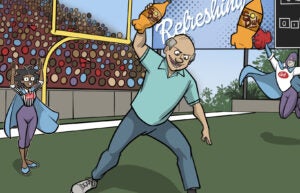Nextdoor wants local advertisers to feel more at home on its platform.
On Wednesday, the company rolled out a bunch of new advertising capabilities, including campaign optimization, contextual weather-based ad targeting and expanded video ad formats.
It’s also testing generative AI creative, AI-powered targeting recommendations and expanded personalization options for image-based ads.
These are all moves right out of the walled-garden playbook. Advertisers love an easy button, especially SMBs.
But, unlike its massive social networking peers, Nextdoor’s pitch is about helping small businesses connect with the people who live, well, next door, the company’s CRO, Michael Kiernan, told AdExchanger.
“We feel we’re different,” Kiernan said. “We have this whole other dimension, which is that we deeply understand where people live and connect locally.”
Home is where the optimization is
Nextdoor released its first advertising product in 2017 in the form of display ads and sponsored posts primarily aimed at promoting local businesses and real estate agents. It kept on adding new features and tools until launching its self-serve ad platform in 2022.
Self-serve is key for busy SMB advertisers that need the flexibility and control to manage campaigns on their own terms, Kiernan said.
“Everyone wants control and everyone wants the ability to manage their business,” he said. “Self-serve allows businesses to operate on their own timeline and on their own schedule.”
Nextdoor’s new features reflect that approach, but also mark a shift toward automation, allowing AI and machine learning to handle more of the day-to-day campaign optimizations so business owners can focus on running their businesses.
Click and conversion optimization, for example, automatically adjusts how ads are delivered to increase the likelihood of user engagement or a specific action, such as a purchase or a sign-up.
Nextdoor looks at a variety of standard signals to determine when to show ads and who to show them to, including which creatives are performing well, the time of day and time spent.
But Nextdoor also incorporates on-platform behavior, including search – if someone’s searching for a handyman or an electrician on Nextdoor, for instance, their intent is pretty clear – alongside data collected from its conversion API (CAPI), which sends information about user actions back to the platform on a server-to-server basis.
“Now we’re at a place where we’re optimizing across enough data points that we’re confident in our ability to dynamically predict the next conversion,” Kiernan said. “Predictive analytics is just the next step for us.”
‘Video is everywhere’
All of this data also feeds Nextdoor’s new geo-personalization feature, which customizes messaging and creative to reflect specific neighborhoods.
Businesses can superimpose neighborhood or city names onto their images, which is easy for Nextdoor to do, because it knows where its users live and not in a creepy way. That’s the whole point of Nextdoor.
Kiernan, for example, lives in Brooklyn, and the closest Home Depot location to him is in Chelsea in Manhattan. “So I might see an ad that says, ‘Hey, Kiernan, 1,100 of your neighbors in Cobble Hill go to The Home Depot on 23rd Street’ as a text overlay right on the image itself,” he said. “That’s something different than what you’re seeing on other social platforms.”
But Nextdoor’s expansion of its video ad formats, by contrast, is quite similar to what we’re seeing across the rest of the social landscape. There’s been a marked shift toward video as the primary format for engagement and storytelling.
“Video is everywhere,” Kiernan said simply.
Nextdoor already had video advertising on its platform, but now it’s introducing video ads within its carousel format. More video just makes sense, Kiernan said. It’s one of the fastest-growing formats on Nextdoor, both in terms of conversions and engagement in the feed.
“Beyond video ads, we’re also increasingly seeing more UGC video posts from our neighbors,” he said. “It really is becoming the most important format.”
(For reference, Nextdoor refers to its users as “neighbors,” sort of like how Reddit calls its users “Redditors.”)
Main Street meets Mother Nature
Last up, Nextdoor is also starting to factor the weather into its ad targeting.
Using data from The Weather Company, businesses can now choose to show certain messages only when local conditions meet specific criteria, like promoting hot drinks when temperatures drop or cold drinks when temps rise.
But that hot/cold drinks example is always the one that companies trot out when they talk about weather-triggered ad targeting. On Nextdoor, weather can power more specific use cases, Kiernan said.
“We’re a very home-centric platform where there’s a lot of dialogue related to home improvement,” he said. “If you think about it, the time of year and the weather has a big impact on the projects you do.”
For example, a sudden cold snap could trigger ads for heater repair services or reminders to winterize the home in affected neighborhoods.
“When it gets cold, there’s usually an influx of people turning on their heater for the first time in a while, and some number of them will probably run into a problem,” Kiernan said. “If I’m an HVAC company, I want to reach these people and I want to do it not just with the right creative but also with the right CTA.”
















